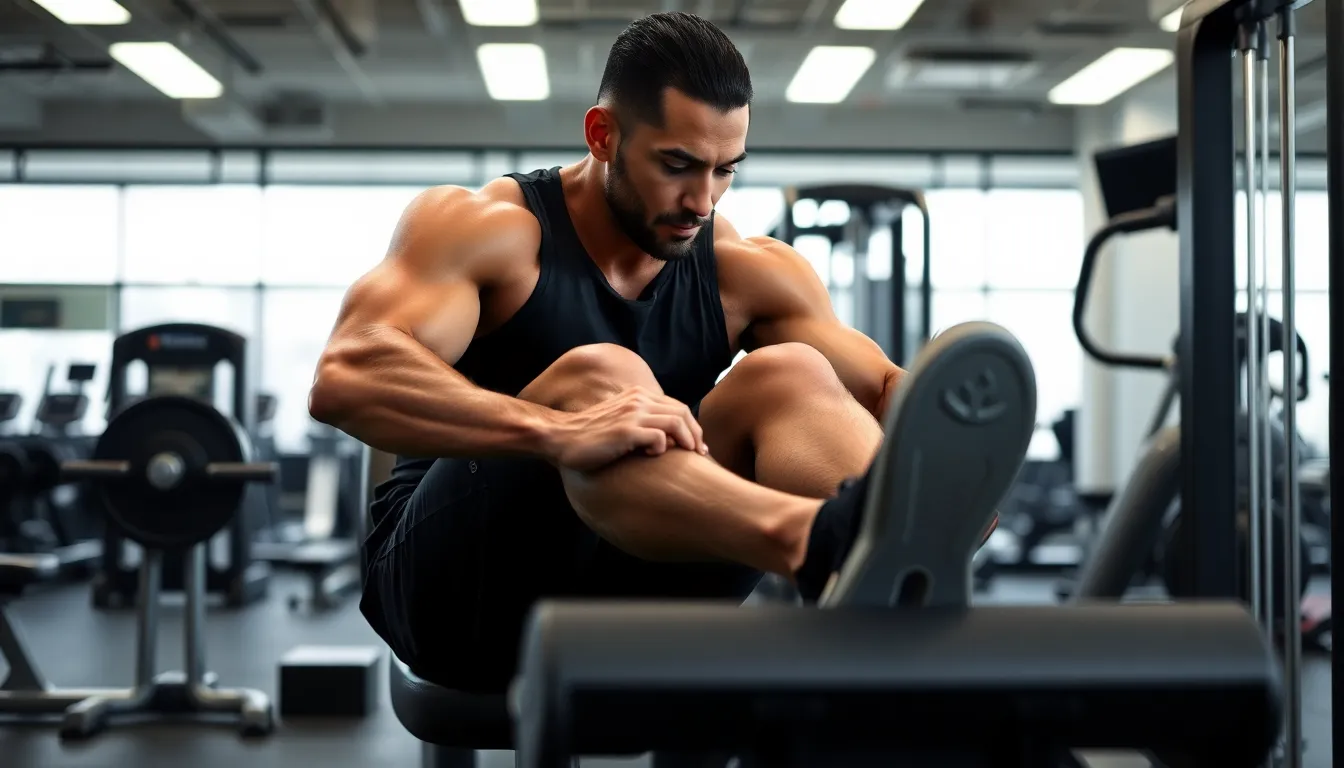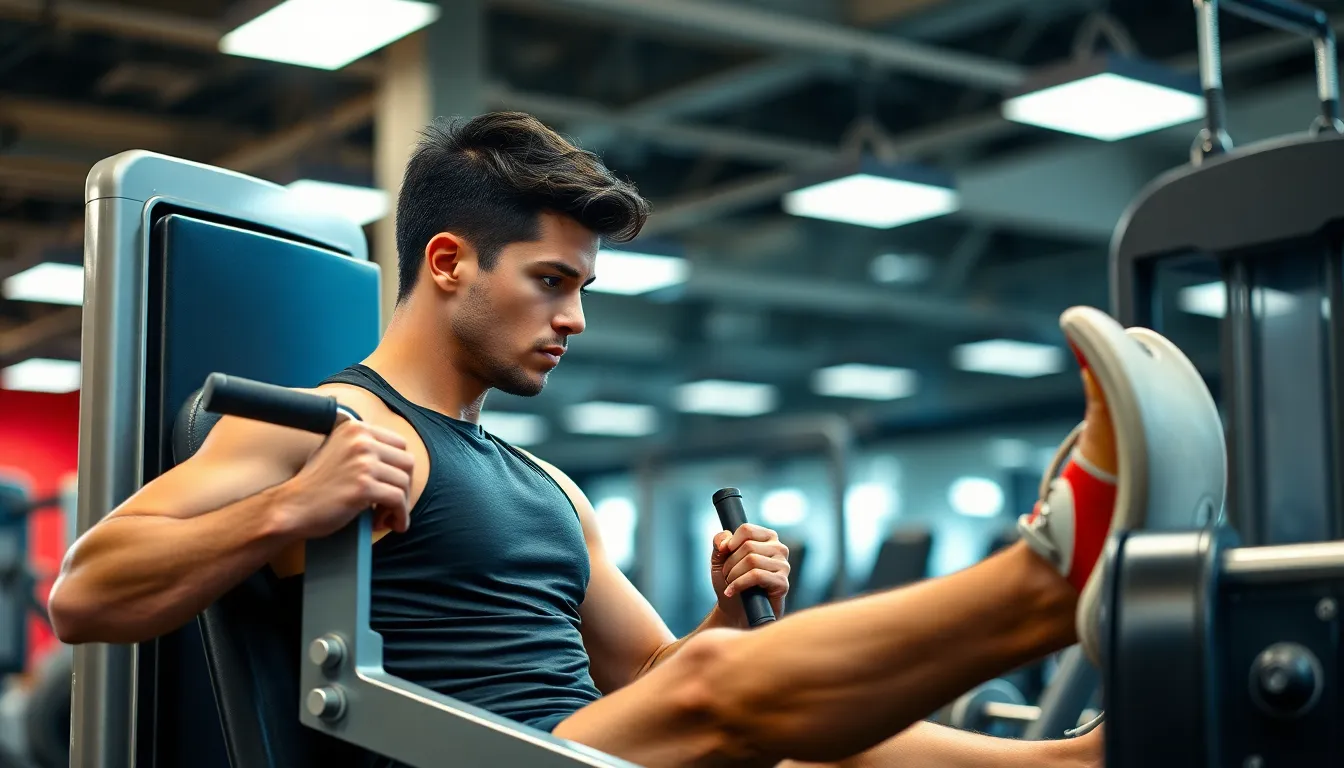Table of Contents
ToggleThe leg press machine might look like a futuristic recliner for gym-goers, but it’s a powerhouse for sculpting those lower body muscles. If you’ve ever wondered what muscles get a workout while you’re pushing that weighted platform like you’re trying to launch it into orbit, you’re in for a treat.
Overview of Leg Press Exercise
Leg press exercises target multiple muscle groups in the lower body, emphasizing strength and hypertrophy. This workout primarily engages the quadriceps, hamstrings, and gluteal muscles. Stepping into the leg press machine initiates a dynamic push that utilizes the legs effectively.
Quadriceps play a critical role during the press, contributing to knee extension. These muscles consist of four main components: rectus femoris, vastus lateralis, vastus medialis, and vastus intermedius. Hamstrings also get activated, assisting in controlling movement and stabilizing the joint. Their three muscles—biceps femoris, semitendinosus, and semimembranosus—work to balance the action during the exercise.
Glutes remain engaged throughout, providing power necessary for pressing the weight upward. This muscle group, including the gluteus maximus, medius, and minimus, adds to overall lower body strength and stability. Calves, particularly the soleus and gastrocnemius, also contribute to the movement as they support ankle flexion and ensure a smooth range of motion.
Using leg press machines offers versatility, allowing adjustments in foot placement to target different muscles. Wider stances activate the inner thighs more, while narrower stances emphasize the outer quads. By incorporating this exercise into workout routines, individuals can strengthen lower body muscles effectively and enhance overall athletic performance.
Primary Muscles Targeted

The leg press primarily engages major muscle groups in the lower body, fostering strength and stability. Key areas of activation include the quadriceps, hamstrings, and gluteus maximus.
Quadriceps
Quadriceps play a crucial role in leg press functionality. This muscle group consists of four components: rectus femoris, vastus lateralis, vastus medialis, and vastus intermedius. These components are essential for knee extension during the press. Strengthening the quadriceps through leg presses contributes significantly to improved athletic performance and overall leg strength.
Hamstrings
Hamstrings assist in controlling movement and stabilization during the leg press. This muscle group, located at the back of the thigh, flexes the knee and plays a supporting role in the exercise. Engaging the hamstrings allows for balanced muscle development, promoting joint stability and enhancing performance in athletic activities.
Gluteus Maximus
Gluteus maximus contributes considerable power when pressing weight upward. This muscle is the largest in the buttocks, providing crucial strength for lower body movements. Engaging the glutes in leg presses leads to improved hip extension and strength, benefiting various athletic and functional movements.
Secondary Muscles Engaged
Several secondary muscles engage during the leg press, contributing to overall strength and stability.
Calves
Calf muscles, primarily the gastrocnemius and soleus, play an essential role in the leg press. It provides stability at the ankle joint during the extension phase. Calves assist in maintaining proper foot placement, preventing unwanted movement. Engaging these muscles enhances overall leg strength and contributes to explosive power in athletes.
Adductors
Adductor muscles of the inner thigh also participate during the leg press. They help stabilize the legs, ensuring alignment throughout the exercise. Engagement of the adductors prevents excessive lateral movement of the knees. This stabilization promotes balanced muscle development and contributes to efficient leg pressing motion.
Core Muscles
Core muscles, including the rectus abdominis and obliques, engage to support the upper body during the leg press. These muscles maintain proper posture and alignment, promoting a stable base for lower body movement. Activation of the core enhances overall strength and prevents injury by stabilizing the spine. A strong core maximizes the leg press’s effectiveness and overall performance.
Benefits of Leg Press
Leg press exercises deliver numerous advantages for lower body strength and overall fitness. Improved muscle development in the quadriceps, hamstrings, glutes, and calves occurs with consistent training on the leg press machine. This exercise enhances the quadriceps, essential for knee extension, and contributes to improved athletic performance and endurance.
Strengthening the hamstrings helps maintain balance and stability during workouts. This muscle group not only supports movement control but also aids in injury prevention, promoting joint health. Furthermore, developing the gluteus maximus significantly increases explosive power, which is crucial for various athletic activities and functional movements.
Incorporating leg presses into a fitness regimen boosts overall leg strength. Increased strength translates to better performance in sports and daily activities. Enhancing stability in the ankle and foot position is another benefit of targeted calf engagement, which supports optimal technique during workouts.
Adjustable foot placement on the leg press machine allows targeting of different muscle areas. This versatility ensures well-rounded muscle development by focusing on specific regions, such as the adductors. Strengthening the adductor muscles encourages proper alignment and balance throughout lower body movements.
Core engagement during the leg press stabilizes the upper body while maintaining posture. A strong core contributes to effective force transfer and reduces the risk of injury during exercise. Ultimately, this exercise promotes a comprehensive lower body workout beneficial for anyone looking to improve overall fitness.
The leg press machine stands out as an essential tool for anyone aiming to enhance lower body strength. By engaging multiple muscle groups including the quadriceps, hamstrings, glutes, and calves, it promotes balanced development and improved athletic performance. The versatility of the machine allows users to adjust foot placement for targeted results.
Incorporating leg presses into a fitness routine not only strengthens key muscles but also supports overall stability and injury prevention. With consistent training, individuals can experience significant gains in power and endurance, making the leg press a valuable addition to any workout regimen.





